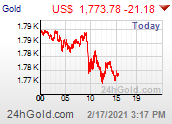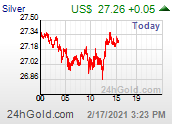Starting today, Investor Intelligentsia will manage a US$200,000 model portfolio. Portfolio
selections will have a bias towards investments in the natural resource sectors, including
exposure to oil and gas, precious and base metals, agriculture, water and
technology companies that help these resource industries thrive. In
addition, extensive coverage of international markets, infrastructure, technology and alternative energy industries will be profiled.
There will be no specific restrictions on the type of
investments and investment methodologies employed. All
portfolio constituents will be
publicly traded securities.
The following orders are now "live" and in place before the market open:
- Agnico-Eagle Mines Ltd. (AEM.NYSE): Buy 400 shares at a limit price of $50, good until canceled.
- Petroleo Brasileiro - aka "Petrobras" (PBR.NYSE): Buy 200 shares at a limit price of $100, good until canceld
- Suntech Power Holdings Co. Ltd. (STP.NYSE): Buy 350 shares at a limit price of $63.75, good until canceled
- Pediment Exploration LTD (PEZ.V): Buy 2000 shares at the open in Canada, and convert basis price to US Dollars for tracking purposes; OTC shares trade in the US under the ticker PEZFF
Agnico-Eagle is a
fabulous company. We profiled them in an earlier message when they were trading in the $30s. With the rise in gold and our expectation that 2008 will see gold trading in four digit price
territory,
Agnico-Eagle remains an attractive core holding for exposure to gold. They are a mid
tier producer with sufficient size to be
attractive to institutional
investors. But unlike larger gold companies suffering from questionable ability to grow reserves,
Agnico-Eagle will be bringing new mines into
production in the coming years, and management has proven to be effective at keeping costs low - not easy in the current mining
environment, what with rising energy costs and shortages of key
resources ranging from skilled engineers to equipment. Earlier comments on
Agnico-Eagle can be read
here.
Petrobras is the national oil and gas company of Brazil. By any metric, it ranks among the largest oil
companies in the world. However, not all oil majors have rapidly expanding reserves. In fact, it's not well
appreciated by average investors that companies like Exxon, Shell and
BP face
tremendous challenges increasing their reserve life
indices. The more well known
publicly traded majors also have
production sharing
agreements with host countries that have percentage royalties that escalate as the price of crude rises. In specific cases, it actually is in the interest of these
companies to see LOWER oil prices! As a state-sponsored entity with the
majority of its assets in Brazil,
Petrobras does not face quite as many onerous production sharing agreements. The company also has a number of stellar attributes, including an extensive deep water drilling technology and highly prospective regions for exploration off the coast of Brazil. Recently, the company announced the discovery of a light grade oil field estimated to hold
between four and eight billion barrels. This news set the NYSE
ADR shares soring to just under the $120 mark, only to see the fall just as rapidly as oil prices corrected toward $90
WTI on a cash basis. There will be more
discoveries announced in the months and years ahead. The basis
Petrobras is exploring is one of the last regions on earth where new large fields are likely to be found. The shares are a compelling value for long-term energy bulls and
simultaneously offer diversification away from US-based political risk. Unfortunately, there is likely more political risk holding a company like Exxon than
Petrobras.
Suntech Power is the largest Chinese
manufacturer of solar panels. They have the scale economies, industry relationships and technology to remain a player for well into the next decade. In this booming industry, that's not a trivial consideration. They are not technology leaders in specific applications such as "thin film" panels, but their product breadth and manufacturing economies have earned them growing market share. They have long-term contracts with silicon suppliers, and they have invested in integrated solar products (solar cell technology developed as part of actual building materials such as roof shingles).
Suntech represents the best value among solar
companies. Even though the shares have witness a
significant move and both trailing and forward price-to-
earnings ratios are not cheap, the shares are still attractively valued relative to the explosive earnings growth the company should generate. Other
companies like
SunPower and First Solar are attractive, but their valuations
are nestled around the flight paths of migratory birds. We will review and consider other solar
companies in the future. For now, a clear
investment case can be made for
SunTechPediment Exploration: Mark Twain once quipped, a mine was nothing more than "a hole in the ground owned by a liar." The mining industry has come a long way since the 1800s, but the sad fact is that the vast majority of exploration companies never graduate to the stage of mine developers or take-out candidates. Pediment is likely on the way to proving the exception to this rule. They have multiple projects in Mexico and more than one chance of bringing a mine operation into production. Throughout the summer, Pediment reported
outstanding drill results at its San Antonio gold project in
Baja, California. Results including a drill hole with 1.64 grams per tone gold over 152 meters. There's no doubt they have found an
economically minable resource. It's just a
question of how big it will be. Gary Freeman, President & CEO, beams when he describes the project in an
interview with Al Korelin and Jay Taylor. But Pediment isn't a one trick pony. The company recently announced
the purchase of "La
Colorada," a gold and silver property in Sonora State, Mexico. It was a high grade underground mine in the 1800s that
was shut down following the Mexican Revolution.
Eldorado gold re-worked the mine between 1993 and 2000 but low gold prices halted that effort.
Eldorado estimated another 450,000 ounces remained (estimate not in compliance with modern Canadian standards), and Pediment's management believes much more gold can be proved-up. They now control an option to
acquire a 100% interest in the project, including
infrastructure and a processing plant, by investing $1.1 million initially, and another $1.8 over
the course of two years. This is a
relatively low risk exploration and re-development operation that has a high
probability of
delivering high value cash flow and low costs. Excitement surrounding the San Antonio project pushed the shares well into the C$1 to C$2 and change range. Today, Pediment is bouncing at about C$3 and attempting to move higher. As investors come to appreciate
development work at "La
Colorada" and other projects in the Pediment stable, the shares should perform
strongly.
Profile, Disclosure, Compliance and Disclaimer: Click Here







